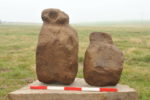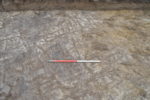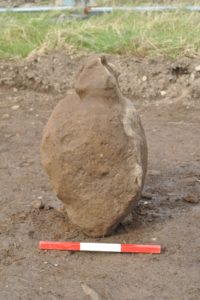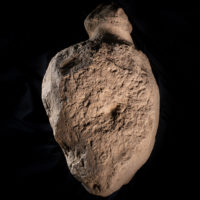 Nine carved Neolithic figures strongly reminiscent of the Shmoo of have been unearthed in Orkney. They were discovered in an archaeological exploration at the site of an electrical substation in Finstown. Underneath two feet of midden deposits, the remains of a structure containing the figures were found.
Nine carved Neolithic figures strongly reminiscent of the Shmoo of have been unearthed in Orkney. They were discovered in an archaeological exploration at the site of an electrical substation in Finstown. Underneath two feet of midden deposits, the remains of a structure containing the figures were found.
Individual examples of these types of carved stones have been found before, usually churned up by ploughs during agricultural work, but this is the first time nine of them have been unearthed in one place. They are also unusually three-dimensional. Most of the known examples are flat with the sides chipped creating the outline of a tiny head or knob over a wider, longer body. These are rounded and carved all around the “neck.”
The archaeologists working on site uncovered the carved stones scattered around a hearth within the remains of an enigmatic structure that contained three cists, two hearths and a partial ring of holes packed with broken off upstanding stones. Three of the roughly carved figures were also important enough to the people who used the building to be incorporated within the structure of one of the hearths and in the foundations of one of the standing stones. The purpose of the building and how it was used by the inhabitants of this site four thousand years ago is still an enigma.
Dating the necked stones firmly will require further work, since they have also been found on Iron Age sites in Orkney. On initial evidence, the ones from Finstown possibly date to around the Late Neolithic or Early Bronze Age, roughly 2000BC. Identifying the purpose of these stones, and if they are figurines, will also require further work, with a close study for abrasion, wear and any other marks on these anthropomorphic objects.
 The archaeologists also discovered evidence of prehistoric farming at the site: clay subsoil marked with gouges left by ards, stone ploughshares shaped into a point. The lines intersect and hashtag each other, evidence of how intensively Neolithic farmers ploughed up the ground.
The archaeologists also discovered evidence of prehistoric farming at the site: clay subsoil marked with gouges left by ards, stone ploughshares shaped into a point. The lines intersect and hashtag each other, evidence of how intensively Neolithic farmers ploughed up the ground.
The trenches have been covered over and all the Shmoos removed and cleaned. They will be conserved and studied while the development plans for the site move forward.


They must have had some practical purpose, in addition to their magical component. A rope or thong around the neck… :confused:
They definitely do look Scottish. Maybe, something to hitch your pony to, i.e. the equivalent of a highlander’s parking lot.
They are large! Three by two-and-a-half red and white things!
Friends,
Livius’ report didn’t mention what shmoos are/were, and most of you won’t remember unless you are as old as I am (I can barely remember them from the early 1960s). Shmoos were characters in Al Capp’s “Little Abner” newspaper comic strip. In the story they were exterminated after being condemned as a threat to national security, though always a few survived to make periodic return appearances in the strip. Shmoos were interpreted many ways, but today they might be seen as a metaphor for the many now-endangered species that are facing extinction thanks to our rampant abuse of the planet, sort of like the dodo.
Wilipedia has a page on shmoos at https://en.wikipedia.org/wiki/Shmoo .
Yours Aye,
Mungo Napier, Laird of Mallard Lodge, SCA
(aka Garth Groff)
I can think of a bunch of more prosaic uses for them before I would call them “figures.” The neck of the lower right example looks smooth like it had a rope around it. 9 in one place would make me think of loom weights first, fishing weights second, beaters or hammers third. I use a stone with a similar shape that I picked off a beach in Orkney as a hammer when trying to knap flint.
Friends,
Livius’ commentary does not mention what a “shmoo” is/was. They were characters in Al Capp’s famous comic strip L’IL ABNER dating from the late 1940s, and occasionally turning up again into the 1960s. They were said to be tasty to eat, nutritious, and for some odd reason, pleased to be cooked and devoured. And they reproduced faster than lemmings. In the storyline, they were deemed a threat to national security (read profits of some capitalists) and hunted to extinction government agents. A few always survived to make a return to the comic strip every few years.
What shmoos represented was never exactly defined, but the strip angered both the left and the right. Today we would probably see them as a metaphor for the many species our rampant exploitation of the planet has driven to extinction. Sort of like dodos.
Yours Aye,
Mungo Napier, Laird of Mallard Lodge, SCA 🦆
(aka Garth Groff)